Cathay Pacific Reviews
NEWS: Cathay Pacific is busy replacing it's A330 fleet with Airbus A350-900s, and there are 6 more Boeing 777-300ERs orders in the pipeline.Read a full trip report here: Cathay Pacific A350 Trip Report.
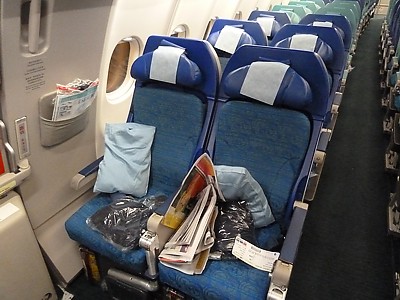
Economy Class Cathay Pacific A330 Emergency Exit seat 54K
Cathay Pacific almost exclusively fly long-haul, which is why all the fleet of 99 is of wide-body aircraft. All of them carry what is called the brush wing livery on the body and on the vertical stabiliser and the Swire Group logo. Cathay Pacific are very traditional in their class of cabin. The airline operates with First, Business, and Economy Class, and despite a lot of talk about a Premium Economy class, have yet to develop one, possibily because this class isn't as well recognised in Asia as it is in Europe. All of the cabins were refitted in 2008, under the codename Olympus.
There are also newer, newish, and old versions of all these seats, as Cathay begins phasing in new cabin interiors and in flight entertainment. Just recently Cathay completed the roll-out of the new versions of all the cabins, with a fixed shell back seat in economy and a narrow coffin like seat in Business: this met with extensive criticism, so Cathay Pacific immediately began another upgrade programme, particularly for Business Class, reintroducing a more traditional seat.
Cathay Pacific Cabin Classes
First Class seats now come in only one type, and have a large wavy back screen giving extensive privacy. They can be converted into a fully lie-flat bed 81 inches long and 31 inches wide(91cm by 210 cm). There is, an ottoman for guests to sit on, and a 17 inch widescreen TV. All the overhead lockers have been removed, however each seat even has a private wardrobe where you can hang your jacket: this is also where the duvet is stored.|
| Cathay A350 Seat map |
| Cathay Pacific A350 Seating Plan | |
| Interactive colour seating chart for A350 Cathay Pacific, with pictures and opinions of every seat in every cabin layout for the CX A350-900. |
Cathay Pacific Business Class
Business class comes in three different types: and it pays to give attention to the aircraft you book on, as different aircraft on the same route have different seats.The latest version of business class is a delight, and while conventional offers high wings, a flat 75 inch bed (26 inch wide) with plenty of lockers to store shoes and headphones. It is on A330 and Boeing 777s. It is called the Cirrus seat, having been designed by Sicma Aero Cirrus The older version of the new Cathay Pacific Business Class seat came in with the Olympus redesign, and is called Coffin Class due to the high walls in a herring-bone configuration, which means you sit at a 45 degree angle to the direction of flight, and it's quite difficult to see out of the window. Some passengers like it due to the privacy, but it hasn't met with widespread favour, because the seats are very narrow (20 inches) with little shoulder room, which results in a very cramped flight that you may not enjoy much. However the seat does recline fully flat (to 78 inches). It is to be found on older A330s and Boeing 777s, as well as all A340s and 747s. Both have a 15 inch widescreen TV. Finally, there is the regional Business Class on some A330s and Boeing 777s, with 45 inch pitch and a 9 inch TV in the armrest.
 |
| Cirrus redesign Business Class |
Cathay Pacific premium Economy Class
Premium Economy on Cathay Pacific is rather good, and similar to Qantas Premium Economy, with a a 38 inch pitch, 19.3 inch seat width and an 8 inch recline. There is a large meal table and cocktail table, plus a 10.6-inch seatback television and noise-cancelling headphones, a power socket for UK/Hong Kong plugs, and a USB charging socket.Cathay Pacific Economy Class
All aircraft now have the new Economy Class seats. Passengers either love them or hate them, because they have a unique feature that stops the passenger in front from reclining into your seat. Instead, each seat has a hard shell which allows the seat forward, and the back to ever so slightly go back by about 20 degrees. Pitch is 32inches (81cm). Width is 17.5inches (44cm). The headrest is not adjustable, which is a pain to sleep in. Cathay Pacific have a 9 inch seatback TV on each seat, with the remote control underneath it. AC power is on a UK style plug behind the seatback. On some early seats, the magazine pocket was under the seats, but on almost all aircraft it is now in the traditional place. Cathay Pacific have now confirmed the latest refit of Boeing 747s will include both the all-new premium economy seats, and going back to the older economy style seats without the hard shell.
 Boeing 777-300ER Cathay Pacific Boeing 777-300ER at Hong Kong |
You can pay for an emergency exit row seat on Cathay Pacific, but unusually, it's not always a good idea. Many of Cathay's emergency exits are placed right next to the toilets, so while you get legroom, you also get light-spill, and people standing next to you. All the middle seats opposite exits or bulks are bassinette seats too (screamer seats where young babies are placed) so you end up being kept awake all night. If you really decide you need the seat, it costs US$100 for each flight (or $25 for short-hall): a return from Sydney to London will then cost an extra US$800 for a couple: at that price, there are airlines offering Premium Economy for only a little more. Even just a little status with Marco Polo Club or any oneworld status gets this perk for free. However, you need to call the ticket office to book them.
| Cathay Pacific Aircraft Codes | ||||
| What does my Cathay Pacific aircraft code mean? | ||||
| Code | Seatmap | First Class | Business | Economy |
| 33B | A330-300 | n/a | Coffin | Shell Back |
| 33E | A330-300 | n/a | New Cirrus | Shell Back |
| 330 | A330-300 | n/a | Regional | Basic |
| 34B | A340-300 | n/a | Coffin | Shell Back |
| 74A | 747-400 | Suite | Coffin | Shell Back |
| 77A | 777-300ER | Suite | Coffin | Shell Back |
One last note about the seats: the seatbelt is something you normally don't pay a second glance at on an aircraft: however the ones on Cathay Pacific are a bit special. They contain an airbag: this is great for safety, however in the case of Cathay Pacific the seatbelts were introduced because of the hard rigid shell of the seat. This causes problems with a new regulation in the US that ensures all aircraft built there must meet standards designed to keep passengers conscious through an impact involving deceleration at 16 times the force of gravity - known as the 16G rule. However the airline's Economy seats rigid shells could create problems in the event of a head impact, and therefore Cathay Pacific needs airbags. The bad news is that this takes up a lot of the seat width, and it's pretty uncomfortable to sit on. It's also a bit of a pain to undo, with a car type clip, rather than a normal aircraft pull handle.
 Boeing 747-400 Cathay Pacific Boeing 747-400 at Hong Kong |
Cathay Pacific Fleet
Cathay Pacific Boeing 747-400
Cathay Pacific have a fleet of 21 Boeing 747-400, all of which are fitted with the "newish" cabin, including the older version of the new Cathay Pacific Business Class seat. They are gradually being taken out of service, and some are placed in storage, but are still found on the routes for which they were designed, including the London to Hong Kong trunk route. They seat 379.First Class is as you expect in the nose, with 9 seats. There are four rows, and one seat stuck incongruously in the middle - seat 4D (the only seat without a window). Cathay Pacific First Class seats have a large wavy back screen giving extensive privacy. They can be converted into a fully lie-flat bed 81 inches long. The guest ottoman is a nice touch, as is the 17 inch widescreen TV. These seats are much nicer than the 777 variant, being wider space, and incidentally there is even a large toilet with a window.
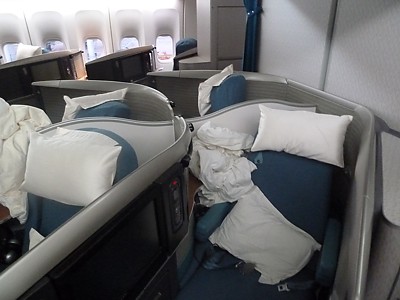 Olympus redesign Cathay Pacific Boeing 747-400 Business Class seat |
Business Class has 46 seats, split evenly between the upper deck and the lower deck. All of Cathay Pacific Business Class seats on the Boeing 747 are of the coffin type, in a herring-bone configuration, split evenly between the upper and lower decks. The upper deck is by far the cabin of choice, with seats either side of the central aisle. There are 7 rows, Row 80 to 87, the door, and then 5 more rows, row 88 to 92. Three toilets on the upper deck (one behind the cockpit, and two at the rear) mean it never gets busy. The lower deck of Cathay's 747 has a 1-2-1 layout, with rows 11 to 17 (row 13 is missing) with only two toilets. Unlike First, in Business all 747s have new expanded overhead lockers, with slightly more space for your case.
Economy Class has a whopping 324 seats, and all of them are the new-type hard shell seat, designed by B/E Aerospace, which gives a slight recline by pushing the seat forward - and not intruding into the seat behind. This a great boon - however it also means you sit on a hard lump in the seat cushion that really isn't that comfortable. Pitch is 32 inches, and all seats have a 9 inch seatback TV with full AVOD. There is AC power on a UK plug behind the tray table, and the literature pocket that has been relocated to below the seat cushion to create more leg room.
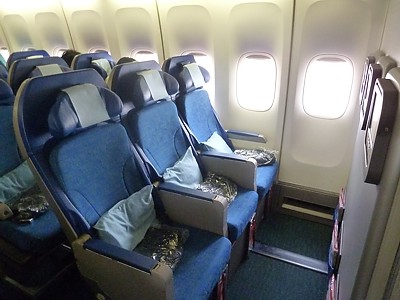 Boeing 747-400 Cathay Pacific Boeing 747-400 Economy Class seat |
Cathay Pacific Economy Class seats are in 3-4-3 configuration.
One perk of the 747 in economy is there is an in-flight snack-bar. This is rarely advertised, and few passengers know about it however a table is placed at the space at the door behind seats 53HJK and filled with nuts, snacks, sandwiches and biscuits.
Beware that there is a group of four toilets at the back of the aircraft, and the rear seats get a lot of passing traffic. There are also two more toilets in front of row 44. This is an emergency exit, and gives loads of legroom, but the light spill will keep you awake all night. Much better is row 55 - a bulkhead behind the galley - and row 30, although there is a toilet on the left, so row 30 HJK is much better.
 Airbus A330-300 Cathay Pacific Airbus A330-300 at Hong Kong |
Cathay Pacific Airbus A330-300 / A340-300
Cathay Pacific have a fleet of 11 Airbus of the longer range A340-300 and a whopping 32 of the twin engine A330-300. None of them have a First Class cabin, and Cathay Pacific A330s are divided into Long-Haul and Regional Variants.On Cathay Pacific Airbus A330 & A340 all seats have a seatback TV, with the latest entertainment systems with Audio and Video On Demand (AVOD) that you can stop and start at will. There are power sockets at every seat, taking all plugs including UK ones. In economy, the IFE equipment box is mounted under the window seat, however it is a very small vertical box by the seat leg and takes up little space.
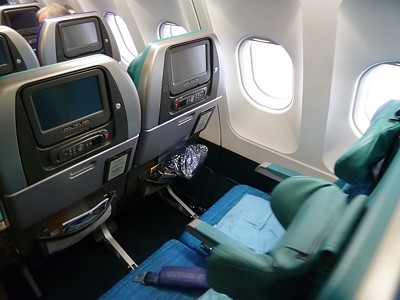 Economy Class Cathay Pacific Airbus A340 Economy Class seat |
All of the Cathay Pacific A340 have the "newish" cabin, including the older coffin version of the new Cathay Pacific Business Class seat. They seat 26 in business, and 257 in economy, making 283 in all. On the A340 the Business cabin is where you'd expect it to be: up front between the front and middle door, with 10 rows (11 to 21), and two toilets, both at the front of the aircraft. The A340 business class cabin is arranged in a herringbone layout, but with two seats facing the aisle on the left (A,D) side, and only one on the right (K) side: as a result meal service is much quicker on the right, and it also has half of the passing isle traffic. No seats are ideal for couples, but at least on the left (A,D) you can chat to a passenger if you are travelling together.
The Cathay Pacific A340 has economy in two cabins, row 30 to 46, and row 54 to 70. Seat row 30, the bulkhead, is heavily favoured, because it has three windows. Avoid anything around the middle of the cabin, where there is a block of 5 toilets: the emergency exit row 54 is a particular nightmare, with continual light spill from the loo. It is even worse on the left, where there are only two toilets, and consequently more people wait in front of seats 54A and 54C, which should be avoided like the plague: the curious cabin design means it is impossible for passengers in one aisle to hop over to the other aisle with more toilets to avoid the queue. A good thing about this cabin is that the seats in front of the rear bulkhead unusually have full recline. Equally avoid seats 66 DEG where the screen in front is exactly half way across from your seat. Bizarrely, the last row, row 70 is heavily favoured, because it has full recline, and you get your meals first on Cathay Pacific's odd rear to front service.
 Business Class Coffin, or Olympus, Cathay Pacific A330 Business Class seat |
These four engine jets are used for ultra long haul destinations, and on some routes such as Hong Kong to London they alternate with Boeing 747 services. Regular travellers, particularly in business, know to take the A340s, because not only are they quieter and newer, but they have noticeably less traffic through the business class cabin.
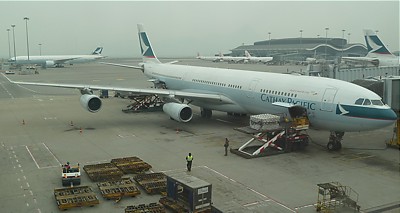 Airbus A340 Cathay Pacific A340 at Hong Kong |
The A340s are particularly fuel heavy, as a result of which four of them have already been sent to rust in the desert, but are still found on the routes for which they were designed, including the London to Hong Kong trunk route, along with Rome, Zurich, San Francisco, and Toronto.
The Cathay Pacific A330 comes in three variants. The most common are 14 A330 in a long haul configuration, of which most have the older newstyle (Olympus Redesign (also known as the coffin)) business class seat, however newer planes have the latest (Cirrus redesign (or more traditional)) business class seat (initially used on the Sydney route, then Melbourne and Adelaide): to find out the version you are on, count the number of business class seats: the older versions have 41 seats, while the new ones have 39. If there are 44 business class seats, it is the regional design version, of which there 18 flying and if possible it should be avoided due to the smaller business class seat and poor inflight entertainment.
The Cathay Pacific A330 cabin layout splits the business class across two sub-cabins. There is the main cabin with ten rows (row 11 to row 21), and a much smaller cabin after the door and galley with just four rows (row 22 to row 25). There are two toilets at the front of the aircraft, and one on the right half way along that is double the size of a normal toilet. Many passengers prefer the smaller rear business class cabin, however it suffers from the blight of being through a thin curtain from the bassinette (screamer) seats in economy. If there is baby in a cot in row 30, you'll get no sleep.
 Economy Class Cathay Pacific A330 Bulkhead seat 30K: TV screens on wall |
For just the same reason, the front of economy in row 30 is either a blessing or a curse. There are three windows at 30A and 30K, however the fear of a child in the bassinette will haunt you. For just the same reason the emergency exit seats in row 54 can be a nightmare, with the added curse of the massive block of 5 toilets ahead of you, with continual light spill from the loo throughout the night. It is even worse on the left, where there are only two toilets, and consequently more people wait in front of seats 54A and 54C, which should be avoided like the plague: the cabin design means passengers can't hop from one aisle to the other with more toilets on the right to avoid the queue. Equally avoid the row of three seats at 66 DEG where there are four seats in front, and the screen in front is exactly half way across from your seat. Bizarrely, the last row, row 70 is heavily favoured, because it has full recline, and you get your meals first on Cathay Pacific's odd rear to front service, plus you can easily hop out and get more drinks from the galley.
International version Cathay Pacific A330s are found on lower density routes such as Hong Kong to Sydney, Melbourne, Adelaide, Denpasar (Bali), Cairns, and Surabaya.
The Cathay Pacific A330 fitted with Regional Business Class has 44 seats in business class, using smaller more upright seats, with a very traditional 2-2-2 layout, with business just in the front cabin, in rows 11 to 19.
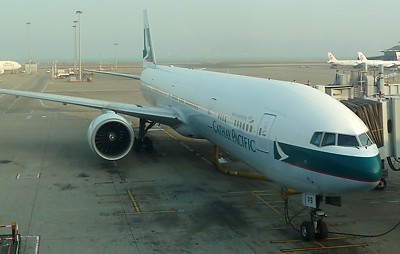 Boeing 777-300ER Cathay Pacific Boeing 777-300ER at Hong Kong |
Cathay Pacific Boeing 777-200 / 777-300 / 777-300ER
Cathay Pacific flies three versions of Boeings large twin jet, the 777, with 35 in the fleet. Most of them are of the long-haul type, the 777-300ER, with three classes, and they are mostly fitted with the newish long-haul Business Class seat. There are currently 18, and a further 28 are on order: slowly they are replacing the 747s on the ultra-long-haul routes, primarily to North America.For the Cathay Pacific Boeing 777-300ER there are six First Class seats in the nose, in two rows.
There are 53 Business Class seats, arranged in herring-bone configuration on the 777-300ER, which is great for solo travellers, but not quite so good if you are travelling as a couple: you need to get pairs of seats facing each other over the aisle if you want to talk to you companion. There are two business class cabins on Cathay Pacific's 777-300ER, and they are very different. The cabin you want is the very small and cosy two row cabin (row 11 and row 12) at the front of the aircraft. Children will not be seated in this cabin, and although it is directly infront of the toilets, there is little light spill or noise from them. Indeed it seems odd that Cathay put in such a large galley and toilet block around the middle set of doors: the rear business class cabin is some distance away, and it is a very different beast. With 13 rows (row 15 to 27) in a 1-2-1 cabin layout, the Cathay Pacific Boeing 777 rear business class cabin is big: and woe betide you if you end up in the rear: it can take a long time before the drinks trolley gets to you.
 Economy Class Cathay Pacific Bulkhead seat, with flipout TV screen |
As for economy, well it's much the same as any other 777, although the are Cathay Pacific's unusual non-reclining economy class seats, include a fixed back shell design that allows passengers to recline without intruding on those seated behind, and which has a 9 inch widescreen seatback TV, and full AVOD. There are 238 seats in economy in a 3-3-3 cabin layout and a 32 inch pitch; this is much better than some airlines like Emirates which shoves a middle seat in the 777, giving a very narrow cramp seat. On the Cathay Pacific 777, the best seats are exactly the opposite of the Airbus, which is to say the Emergency Exit seats in row 54 are great - and nowhere near the toilets. Alas row 31 (or 30 DEG) are a nightmare, with just two small toilets for most of the cabin ahead of you, and your night flight will be blighted by light spill and noisy children; all of row 30 and 31 are bassinette (screamer, or cot) seats. Oddly, row 66 at the back of the cabin are very good, with full recline, and only 2 seats into the aisle which is a real bonus for couples. Plus, on half of the flights, you will be served meals in these seats first. Alas, they are directly infront of the block of four toilets in the rear.
All other Cathay Pacific 777s fly in regional configuration, with older small business class seats. Regional means all destinations within Asia, including India and the Middle East, but not Australia. These Regional Business Class seats have 20 in width and 45 inches (110cm) of pitch. They recline about half way. There is a small 9 inch TV screen in the armrest, with films on an old-style loop (no AVOD).
The Cathay Pacific Boeing 777-300 regional variant have two cabins, with just one cabin of business class, of six rows (row 12 to 18) in a 2-3-2 cabin layout, and then three sub-cabins of economy. Here the best seat is definitely the emergency exit row 58: much better than row 44 which is blighted by the block of 4 toilets ahead of it. Note that until last year, the 777-300 had a small business class cabin of 2 rows after the second set of doors, but economy seats now occupy this space. The Boeing 777-300s are operated on regional routes between Hong Kong and Bangkok, Seoul, Taipei and Japan.
The Boeing 777-300 is a stretched version of the 777-200. Cathay Pacific became the first airline to acquire this efficient, high-capacity aircraft in May 1998; alas, come of these aircraft are looking a little tired now. The business class cabin on the 777-200 is pretty much the same, but in economy there are only two sub-cabins, with row 30ABC the best: a bulkhead away from noise, light and toilets.
Next page: Cathay Pacific IFE inflight entertainment >>>| Cathay Pacific Fleet | |
|---|---|
| www.airreview.com | rating:
6 out of 10

|